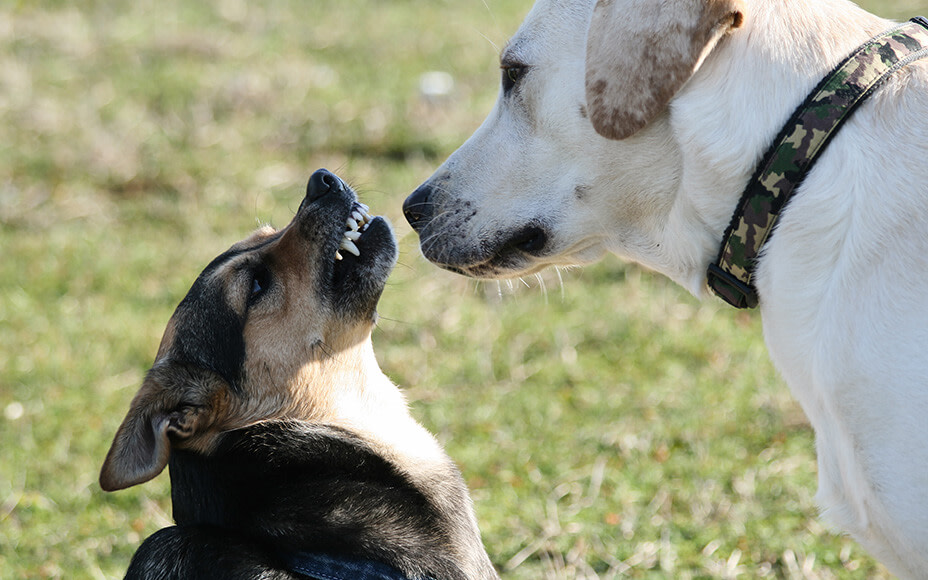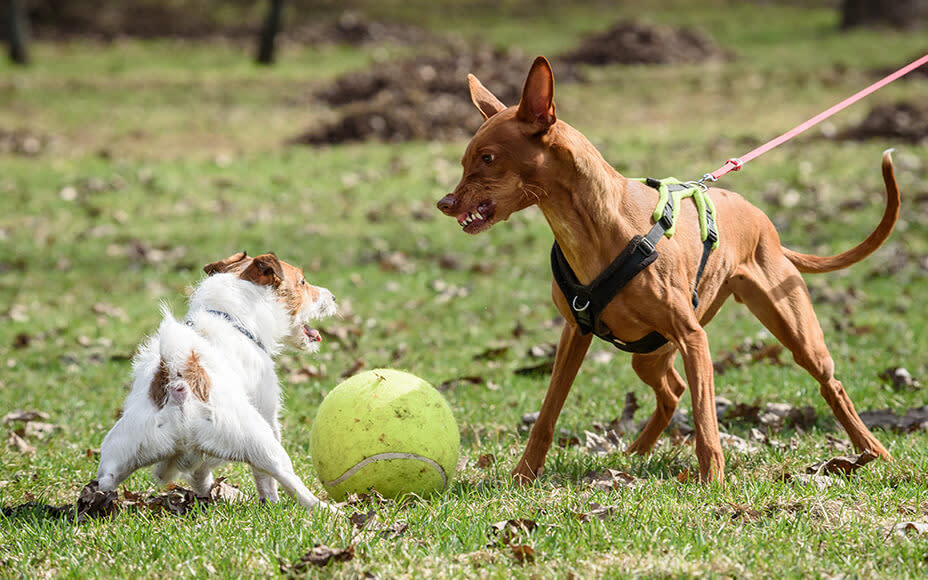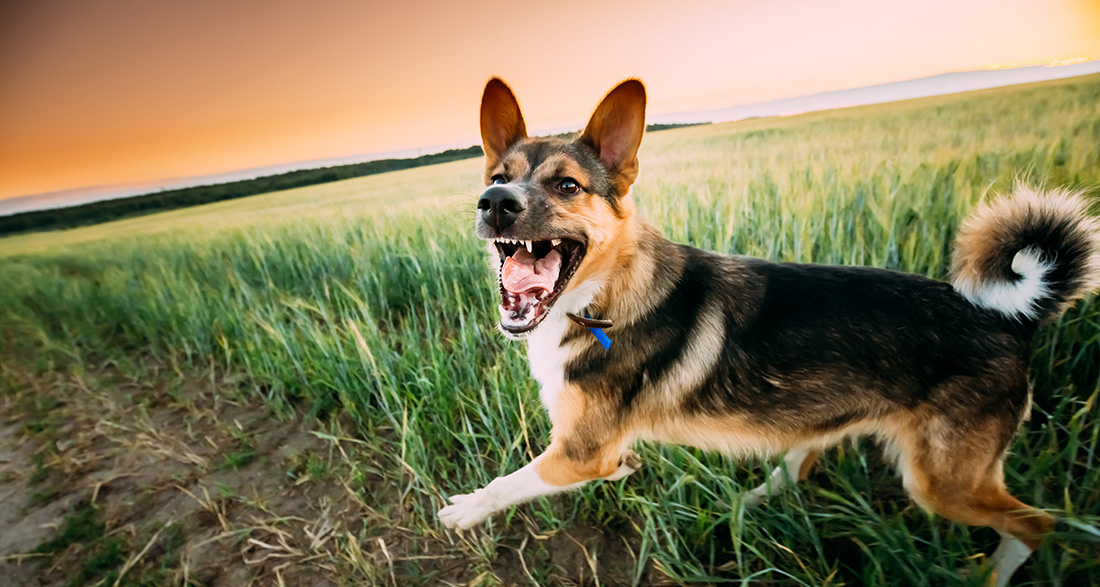Your dog barks, howls, growls, or occasionally snaps? Learn what aggressive dog behavior means and how you can change it sustainably.
- Help, my dog is aggressive!
- Training Aggressive Behavior in Dogs
- Growling, barking, snapping – is that normal?
- What Is the Cause of Your Dog’s Aggressive Behavior?
- Understanding and Interpreting Canine Body Signals
- An Example: The Dog’s Goal = Keeping Humans at a Distance
- Preventing Aggressive Behavior in Dogs Through Correction?
- Is There a Dog Aggression Training?
Help, my dog is aggressive!
Just a moment ago, your dog was beautifully cuddling with the child, and suddenly – snap – he bites or even wants to bite? At home, your four-legged friend is a true angel, but outside, he barks at other dogs or people, jumps, and pulls on the leash? When it comes to food, your dog has no sense of humor and growls at you with bared teeth?
When your own dog shows aggressive behavior, many dog owners are not only surprised but also desperate. However, what many do not know: a dog rarely displays aggressive behavior suddenly and without warning. Unlike humans, dogs communicate a lot through body language. When a dog exhibits aggressive behavior, such as snapping, there are often important signals that precede this action. The reasons for displaying aggressive behaviors can also be quite diverse. For this reason, it is crucial to understand the body language of your own dog and dogs in general.

Training Aggressive Behavior in Dogs
First and foremost, we want to emphasize that aggressive behavior in dogs is something serious. Before the situation worsens or undesirable behaviors in your dog become entrenched, you should seek the help of trained dog trainers. Researching tips online or completing an online dog training course can be helpful. However, for a long-term behavior change in the dog, individual training is often required.
Dog trainers come to your home, listen carefully to your story, and observe how you and your four-legged friend interact. They explain the cause of your dog’s aggressive behavior and discuss possible training approaches to work on together. Each dog-human team is unique, and training paths look just as unique.
Growling, barking, snapping – is that normal?
Did you know that aggressive behavior is entirely normal and part of the repertoire of dog communication? Logical, isn’t it? Dogs are living beings and feel more than just joy over food or the next cuddle session. Frustration, insecurity, or fear are also part of it. Some dog breeds are inherently predisposed to have a higher protective or guard instinct, leading them to show aggressive behaviors more frequently.
Of course, your dog should not simply nail everyone during your walks or engage in fights with every dog in the field. Nevertheless, it is essential to understand that aggressive behavior in dogs belongs within a certain range and is not always synonymous with malicious intent to cause injury. For this reason, it is crucial to first identify the cause of your dog’s aggressive behavior.

What Is the Cause of Your Dog’s Aggressive Behavior?
Unlike humans, dogs cannot verbally express what is bothering them. Nevertheless, they usually make it clear to us through body language! For example, a dog that does not like to be touched may initially show this by turning its head away, yawning, quick eye blinking, or even standing up and walking away. If we persistently force the dog (unwittingly) into close contact, he may eventually snap to defend his boundaries more clearly.
In addition to exceeding the so-called individual tolerance, other possible causes for displaying aggressive behavior in dogs include:
- Insecurity
- Fear
- Bad experiences/past
- Guard and protective instinct
- Hunting instinct
- Frustration
- Status
- Illness
- Pain
Several causes may be relevant simultaneously. For example, a dog with low frustration tolerance and insecurity around other dogs may be more likely to bark while on the leash than a confident and relaxed dog. Furthermore, some of these causes influence each other, such as when a dog has had a painful bicycle accident and is now afraid of all cyclists, barking loudly at them.
Quick Tip:
Have your dog examined by a veterinarian. Perhaps an illness causing pain is behind the aggression? A disturbance in the hormonal balance or other health issues can also contribute to aggressive behavior. If your dog struggles with vet visits, you can reward him with tasty treats during and after the treatment!
Understanding and Interpreting Canine Body Signals
When we talk about aggressive behavior, we usually think of biting, barking, and growling. As mentioned earlier, however, these behaviors are often preceded by numerous other body signals – the so-called appeasement signals, displacement behaviors, and stress signals. All these body signals, ranging from subtle appeasement signals to multiple bites with the intent to injure, are classified into so-called escalation stages. These can be likened to a traffic light:
Escalation Stages:
- Green Zone – all good, the dog politely indicates that something bothers him: Behaviors like yawning, shaking, turning the head away, or licking the snout are in the green zone.
- Yellow Zone – be cautious, the dog more explicitly shows that something is wrong: Behaviors like barking, raised hackles, or biting the leash are still in the yellow zone.
- Red Zone – emergency brake, your dog sees no other way out: Behaviors like snapping at the air, inhibited biting to uninhibited biting are in the red zone.
Depending on their individual experiences, each dog will show certain appeasement signals and behaviors more or less frequently, or never.

An Example: The Dog’s Goal = Keeping Humans at a Distance
A dog that you adopted secondhand may react aggressively to other people and bite due to numerous bad experiences. Perhaps his appeasement signals were ignored in the past, and he learned that biting is the only way to succeed in keeping people at a distance.
A dog that comes to you as a puppy and learns from an early age that his individual tolerance is respected, and the slightest appeasement signals are taken into account, has learned that he achieves success with this behavior (human withdraws) and will not bite directly.
Preventing Aggressive Behavior in Dogs Through Correction?
Correction in dog training can take various forms. Even a simple “No” or a short “Hey!” is a verbal correction. Under no circumstances should you try to correct your dog’s aggressive behavior on your own. This can only worsen the situation. Actions like pushing the dog to the ground, holding the muzzle shut, or pulling forcefully on the leash are not suitable tools to help the dog sustainably.
Correction can help your dog understand that he made a mistake and something is undesirable. At the same time, you must show him the desired behavior and encourage or reinforce it. Additionally, it is crucial to work on the cause of aggression and, ideally, help your dog learn alternative behavior, becoming more confident and relaxed in life. Correction should never be about merely suppressing aggressive behavior and keeping the dog “down.”
A trainer should assist you in this process. Ensure that you choose a professional with whom you feel comfortable, enjoy working together, and support their training approaches.

Is There a Dog Aggression Training?
As you can see, the topic of aggressive behavior in dogs is quite extensive and profound. A simple correction is usually not enough. To truly change your four-legged companion’s behavior and become a team together, collaboration with experienced dog trainers is almost inevitable.
Since dogs, unlike humans, cannot express what bothers them with words, and we cannot explain to them with words to walk calmly past other dogs, a specific dog aggression training can be helpful. In most cases, the key to changing the dog’s behavior lies with the owners. This means that with the right trainer by your side, you can learn a lot about yourself and your dog, gain more insights into dog body language, and provide your dog with the security and leadership he needs.


